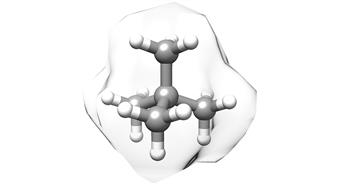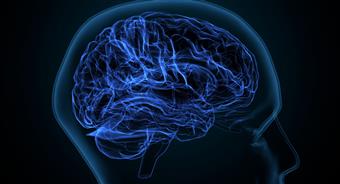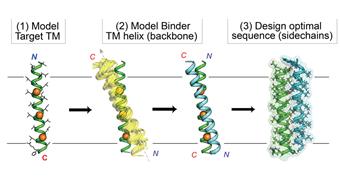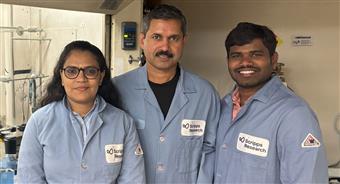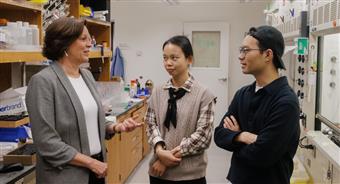
Fighting free radicals with finesse Bioresponsive sensor from Carroll lab activates antioxidants only when needed, provides a new tool for studying reactive oxygen species' role in health and disease.
October 25, 2021
JUPITER, FL Mitochondria provide an estimated 90 percent of the body's energy, making them critical to good health, especially in energy-hungry cells like neurons and muscle.
However, they also produce an estimated 90 percent of the body's free radicals, especially reactive oxygen species (ROS), which have the potential to wreak havoc in cells, damaging DNA and proteins.
When the body is under stress, fighting infection or disease, mitochondria churn out potentially damaging amounts of free radicals, leading to cell injury and death. A new discovery from Scripps Research chemist Kate Carroll, PhD, of Jupiter, Florida, offers an improved way to study the impact of free radicals. The work, published in the journal Nature Chemistry Sept. 16, may hold potential therapeutic applications as a bioresponsive, pro-drug delivery vehicle.
Reactive oxygen species are negatively charged, unbound oxygen molecules that zip about looking for a place to rest. Antioxidant vitamins like vitamins C, E and beta-carotene soak up such free radicals. However, it has recently become clear that free radicals like ROS aren't just trouble makers. They also play important signaling roles in the body, such as activating the immune system. They may play other roles as well, but scientists have lacked the chemical tool box to readily study them until now.
Free radicals' complex, good/bad roles in the body may explain why antioxidant studies for treating Alzheimer's, cancer and other conditions have shown inconsistent results, and in some cases, shown harm. There's likely a Goldilocks just right level, neither too much nor too little, which makes dosing antioxidants problematic.
There's a need for a sensor that we could incorporate into a drug to make it active when there's a pathological level of reactive oxygen and nitrogen species, or a normal level, Carroll says. We have developed such a sensor. It only becomes functional in the face of pathological levels of reactive oxygen species.
Carroll's sensor has an affinity for the same molecular addresses favored by free radicals, meaning they could serve as a pro-drug to drive therapeutic compounds such as antioxidants directly to the places where free radicals would do harm, in the mitochondria or on the sulfur sites of vulnerable proteins. The compounds activate bioresponsively, only after ROS output overwhelms the cells' usual systems for managing them, Carroll says.
Carroll describes creating the sensors, called WYne, with the help of a substance called a Wittig reagent. Bound with fluorescent or other tags, the tools can illuminate where free radicals react in mitochondria and cells, typically, the sulfur sites of cysteine amino acids.
Carroll anticipates the tool will be used in multiple ways: to facilitate the growing field of reactive oxygen and nitrogen species research, to empower studies of mitochondria, and potentially to enable development of the first mitochondria-directed therapeutics.
There is no FDA-approved drug to cure or even significantly prevent progression of mitochondrial-based diseases, Carroll says. We implemented an antioxidant-based mitochondrial delivery system that is bioresponsive.
A bioresponsive antioxidant therapy could alleviate inflammation in diseases such as irritable bowel diseases and chronic intestinal inflammation. It could also be engineered to deliver more selective therapies to target cancer, aging or other degenerative diseases associated with elevated oxidative stress, she adds.
This chemical switch we have designed responds to elevated levels of reactive oxygen species, and then it undergoes a transformation to become the active form of the drug or molecule, Carroll explains. It unmasks the active part of the drug.
Creation of the bioresponsive molecule has grown out of years of research from the Carroll lab into the biochemistry of reactive oxygen species and their impact on the sulfur-rich amino acid cysteine. She previously found that cells make an enzyme whose job is to repair oxidative damage to cellular proteins. These enzymes appear to become silenced when ROS reach pathological levels.
The difference between healthy and dangerous levels of antioxidants in the brain isn't yet well-understood. Malfunctioning mitochondria can lead directly to devastating inherited childhood disorders like Leigh syndrome. In other disease processes, such as those that drive Alzheimer's, mitochondria become collateral damage to cells under stress. The stress leads neurons' mitochondria to churn out pathologic amounts of free radicals, and it's believed that the ensuing damage accelerates neuron death.
There's a whole host of diseases associated with inflammation that in theory would benefit from this compound as a drug, Carroll says. I think with this publication we are going to stimulate a new field of people thinking about how they can use redox tools (reduction-oxidation) to activate drugs. We have shown it is chemically possible and now people can apply this concept to any number of systems or compounds.
The study, Wittig reagents for chemoselective sulfenic acid ligation enables global site stoichiometry analysis and redox-controlled mitochondrial targeting, appears in the Sept. 16, 2021 issue of Nature Chemistry. In addition to corresponding author Carroll, the first author is Yunlong Shi of Scripps Research, and Ling Fu and Jing Yang of the National Center for Protein Sciences in Beijing, China.
This work was supported by the National Institutes of Health R01 GM102187 and R01 CA174864 to Carroll, and the National Nat
More from Scripps
20/04/2024
New copper-catalyzed C-H activation strategy from Scripps Research Two-mode reactions inspired by human detox enzymes offer powerful new tools for drug discover...
12/04/2024
Scripps Research chemists devise easier new method for making a common type of building block for drugs Scientists transform simple linear amines into saturated...
06/04/2024
A simple, inexpensive way to make carbon atoms bind together A Scripps Research team uncovers a cost-effective method for producing quaternary carbon molecules,...
04/04/2024
Developing a vaccine for the zombie drug xylazine Scripps Research chemical biologists design an early proof-of-concept vaccine that could lead to the first...
30/03/2024
How blocking a neural receptor responsible for addiction could reduce alcohol use A Scripps Research team found that a new therapeutic that targets the kappa op...
13/03/2024
New computational strategy boosts the ability of drug designers to target proteins inside the membrane Customized-design approach could streamline the design of...
29/02/2024
Scripps Research scientists reveal how first cells could have formed on Earth New phospholipid discovery brings researchers closer to understanding how primordi...
29/02/2024
How molecular handedness emerged in early biology Scripps Research chemists fill a major gap in origin-of-life theories.
February 28, 2024
LA JOLLA, CA Mole...
22/02/2024
Snaking toward a universal antivenom Scripps Research scientists discovered antibodies that protect against a host of lethal snake venoms.
February 21, 2024
...
06/02/2024
Calibr-Skaggs announces expansion of option and license agreement with AbbVie to develop novel cell therapies for solid tumors and autoimmune diseases
AbbVie...
26/01/2024
Re-energizing mitochondria to treat Alzheimer's disease Scripps Research team restored neuron-to-neuron connections in human cells.
January 25, 2024
LA JO...
24/01/2024
100 years of Science Changing Life: Scripps Research celebrates a century of transforming human health For the last century, institute leaders and renowned scie...
23/01/2024
New technology lets researchers track brain cells' off switches The method could shed light on what goes awry in numerous brain conditions when neurons ar...
09/01/2024
Three decades of giving: Announcing the Calibr-Skaggs Institute for Innovative Medicines The ALSAM Foundation, founded by the Skaggs family, provides lasting g...
04/01/2024
Life science entrepreneur Gene Lay joins Scripps Research Board of Directors Lay, founder of the global biotech company BioLegend, brings invaluable experience ...
21/12/2023
Taming a plant-derived toxin Scripps Research team modifies the traditional poison picrotoxinin for potential neurological drugs and anti-parasite treatments. ...
19/12/2023
Scripps Research Executive Vice President Eric Topol gives TED talk on transformative power of AI in medicine Topol provides an overview of how AI models can i...
13/12/2023
New AI-powered algorithm could better assess people's risk of common heart condition Early detection of atrial fibrillation can reduce the risk of stroke an...
07/12/2023
Nanoparticle flu vaccine design shows promise in early tests Scripps Research-designed vaccine could provide broad, enduring protection against influenza A str...
16/11/2023
Numerous Scripps Research scientists named Highly Cited Researchers Clarivate's annual, global list represents researchers who have demonstrated significant...
07/11/2023
Multiple sclerosis drug invented at Scripps Research slows long-term devastating disease progression Late-breaking data reinforces the effectiveness and safety ...
05/10/2023
Keren Lasker named a 2023 Moore Inventor Fellow The prestigious award will support Lasker's inventive research in membraneless organelles and their applica...
22/09/2023
Michael Bollong named a 2023 Amgen Young Investigator The prestigious award will support Bollong's research identifying new molecular targets and therapeuti...
09/09/2023
Philip Dawson receives 2024 American Chemical Society National Award Dawson is honored with the Arthur C. Cope Late Careers Scholar Award for his foundational c...
07/09/2023
Scripps Research chemists devise a method for C-H activation of alcohols The method represents a new toolkit for making drugs and other compounds.
September 06...
31/08/2023
Scripps Research receives $1.5M to surveil infectious disease threats in wastewater Bill & Melinda Gates Foundation award to support the development of multi-pa...
16/08/2023
How cold temperatures trigger the brain to boost appetite Scripps Research scientists' discovery could lead to new weight loss and metabolic health treatmen...
08/08/2023
Human antibody that targets carfentanil, fentanyl and related opioids reverses overdose effects in preclinical study Scripps Research-developed antibody therapy...
04/08/2023
How sensory neurons impact the gut Scripps Research scientists show that the receptor PIEZO2 in sensory neurons controls gut motility and transit time, which a...
26/07/2023
AbbVie and Calibr Expand Strategic Collaboration to Advance Several Preclinical and Early-stage Clinical Assets The expanded strategic collaboration will advan...
23/07/2023
Scripps Research scientists develop AI-based tracking and early-warning system for viral pandemics Machine-learning system effectively predicts emergence of pro...
19/07/2023
Monitoring T cells may allow prevention of type 1 diabetes Scripps Research study shows that analyzing T cells in blood samples could be used to select at-risk ...
19/07/2023
Scripps Research mourns passing of leading organic chemist Albert Eschenmoser Eschenmoser pioneered key reactions in synthetic chemistry and shaped the understa...
15/06/2023
Scripps Research awarded $46.8 million by NIH to promote human health through innovative translational science and training The Translational Institute is harne...
13/06/2023
Scripps Research's Danielle Grotjahn named 2023 Pew Scholar in the Biomedical Sciences The award will support Grotjahn's study of how cells assemble the...
31/05/2023
Crossing the ring: new method enables C-H activation across saturated carbocycles Scripps Research chemists add another powerful tool to their molecular editin...
24/05/2023
Scripps Research develops behind-the-scenes tool for better biomedical data discovery The new resource makes datasets more discoverable for life science communi...
19/05/2023
Scripps Research neuroscientist Hollis Cline elected to American Academy of Arts and Sciences Cline is recognized for her discoveries about the role of sensory ...
19/05/2023
Scripps Research's Skaggs Graduate School awards doctoral degrees to 31st graduating class Commencement ceremony will be livestreamed via Zoom and on instit...
13/05/2023
A better route to benzocyclobutenes, sought-after building blocks for drugs Scripps Research chemists devise a new, C-H activation-based method for the synthesi...
09/05/2023
Renowned Scripps Research professor Jeffery Kelly elected to National Academy of Sciences Kelly's groundbreaking work on protein misfolding has led to thera...
28/04/2023
Mirror-image molecules pave new path for cancer drug discovery By comparing how mirror image versions of small molecules impact clusters of proteins, Scripps R...
22/04/2023
How alcohol consumption contributes to chronic pain A Scripps Research team showed how both alcohol intake and alcohol withdrawal can lead to increased pain and...
21/04/2023
Xin Jin receives dual awards to study autism risk genes in neurodevelopment Major grants from the National Institutes of Health and California Institute for Reg...
20/04/2023
Trim the sugar: New HIV vaccine design improves immune response Scripps Research vaccine candidate headed for clinical trials.
April 19, 2023
LA JOLLA, CA A...
18/04/2023
Therapeutic can seek and destroy potent opioid to treat overdoses Scripps Research chemists developed a new biologic to work against the synthetic opioid carfen...
07/03/2023
How heavy alcohol consumption increases brain inflammation The findings by a Scripps Research team point toward a potential new drug target for treating alcohol...
02/03/2023
Scientists find human antibodies that can block multiple coronaviruses including SARS-CoV-2 Results from a Scripps Research and UNC team pave the way for a vacc...
28/02/2023
$10 million grant funds Scripps Research Alcohol Research Center through its 50th year The five-year grant supports research into the neurobiology of alcohol us...
28/02/2023
Immune system drug shows promise in treating alcohol use disorder, a Scripps Research clinical trial reports Scientists at Scripps Research found that apremilas...
 Fighting free radicals with finesse Bioresponsive sensor from Carroll lab activates antioxidants only when needed, provides a new tool for studying reactive oxygen species' role in health and disease.
Fighting free radicals with finesse Bioresponsive sensor from Carroll lab activates antioxidants only when needed, provides a new tool for studying reactive oxygen species' role in health and disease.















